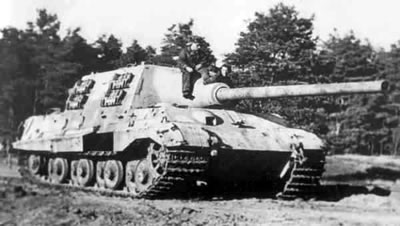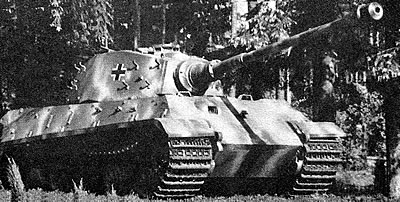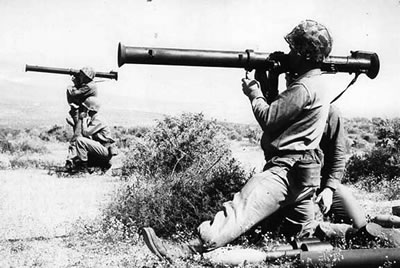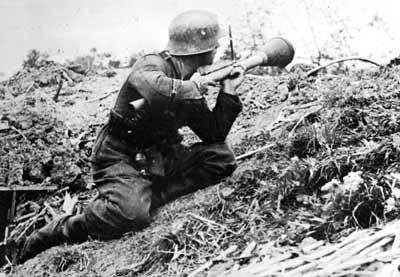Tanks developed much more rapidly in World War II than any time before, with all the major tank building countries designing and making bigger, faster, better armored tanks as the war progresses. The UK had been the leader in cutting edge tank technology in World War One, but by the outbreak of World War Two she had lagged far behind. British tanks at the start of World War Two were old, lumbering beasts with puny armor and pathetic firepower and were no match for the Blitzkrieging panzers of Germany.
The British tanks had light armor and weapons, more suited to civilian crowd-control and perhaps scouting missions and training at best. Their turret ring mountings were too small to be upgraded with large enough guns to compete with contemporary tanks. The German PzKpfw III’s and PzKpfw IV’s were made in the early 1930’s and had wider mounting rings, which made them upgradable to the latest gun designs so they were still in mass production well into the 1940’s.
The Americans were pretty new to the field of tank battles, but they were quick to realize it was often the tank that scored the first hit that won individual fights with other tanks. With this in mind, America designed its tanks with dual-purpose main tank armament and stabilized the gun platform so it could hit targets while they were moving. The American Medium M3 Lee/Grants was first used with the British Army in the deserts of North Africa. The Medium M3 was their first tank with a large gun with dual capability since the Heavy Mark IV with its six pounder in World War One. It did achieve some success with its large 2.95 inch/75mm gun, but the M3 stayed in use for far too long, so that its effectiveness was lessened by the increased performance of enemy tanks.
 The first real heavy-weight contender amongst the British tanks was the A34 Comet, which was used from March 1945 and had a 3.03 inch/76mm gun.
The first real heavy-weight contender amongst the British tanks was the A34 Comet, which was used from March 1945 and had a 3.03 inch/76mm gun.
Technology-wise, the Germans led the way with their tank designs and, apart from the Russian T-34, created the most effective tanks of World War II. However, as the war progressed, Germany could not compete with the industrial might of both America and Russia and the sheer numbers of tanks both countries produced. In fact some argue that Germany unwisely used some of their tank production on frivolous designs, trying to create bigger and stronger tanks with increased ingenuity, when they should have been utilizing their  smaller resources to churn out the reliable tanks that’d already been proven in battle time and again. These larger, better armored tanks include the King Tiger tank at 68 tons, the slightly heavier Jagtiger at 70 tons and the outrageously gigantic Maus, which was never used, at 180 tons. It was true that these mega-tanks could destroy any other tank they came across, but they drank fuel like a battleship, needed reinforced bridges to cross rivers and were very difficult to maneuver. Having said that, there are many tank enthusiasts who, to this day, are very fond of the German World War II mega tanks, the King Tiger Tank pictured here is a particular favorite for many. Here is a website dedicated to the German King Tiger Tank.
smaller resources to churn out the reliable tanks that’d already been proven in battle time and again. These larger, better armored tanks include the King Tiger tank at 68 tons, the slightly heavier Jagtiger at 70 tons and the outrageously gigantic Maus, which was never used, at 180 tons. It was true that these mega-tanks could destroy any other tank they came across, but they drank fuel like a battleship, needed reinforced bridges to cross rivers and were very difficult to maneuver. Having said that, there are many tank enthusiasts who, to this day, are very fond of the German World War II mega tanks, the King Tiger Tank pictured here is a particular favorite for many. Here is a website dedicated to the German King Tiger Tank.
Anti-tank Weapons
 It was during WWII that anti-tank weapons began to be developed properly, both handheld and aircraft-mounted. Armor piercing/penetrating shots were improved, but there was also a new type of ammunition developed alongside kinetic ammo, that of High-Explosive Anti-Tank (heat) ammo that utilized the chemical energy created from the high-speed, high-temperature jet of the High Explosive. These types of rockets were fired at close range by soldiers, using such weapons as the Bazooka with two men (one shoots, one loads) or the pre-loaded single-shot Panzerfaust (armor fist) used by one man.
It was during WWII that anti-tank weapons began to be developed properly, both handheld and aircraft-mounted. Armor piercing/penetrating shots were improved, but there was also a new type of ammunition developed alongside kinetic ammo, that of High-Explosive Anti-Tank (heat) ammo that utilized the chemical energy created from the high-speed, high-temperature jet of the High Explosive. These types of rockets were fired at close range by soldiers, using such weapons as the Bazooka with two men (one shoots, one loads) or the pre-loaded single-shot Panzerfaust (armor fist) used by one man.
One of the biggest threats to tanks then, and now, was the tank-buster aircraft, or Jabos (Jagdbombers). These were aircraft whose main mission was to seek out tanks and destroy them from the air. This danger increases as one side achieves air-superiority, as the allies did in the last years of the war.
 Because of the anti-tank weapon threat, armor had to be upgraded. ‘Stand-off armor’, armor plates, were fitted to the sides of tanks to protect the tracks and suspension, which were one of the main vulnerable areas when attacked by bazooka from tree-lines at the side of roads for instance. Magnetic land mines were a big danger for tanks also, so some tanks were painted with special anti-magnetic paste. Frontal and turret armor became ever thicker and tanks were fitted with smoke launchers so they could disappear and escape to cover.
Because of the anti-tank weapon threat, armor had to be upgraded. ‘Stand-off armor’, armor plates, were fitted to the sides of tanks to protect the tracks and suspension, which were one of the main vulnerable areas when attacked by bazooka from tree-lines at the side of roads for instance. Magnetic land mines were a big danger for tanks also, so some tanks were painted with special anti-magnetic paste. Frontal and turret armor became ever thicker and tanks were fitted with smoke launchers so they could disappear and escape to cover.
Engines were also developed a lot during WWII, though a lot of tanks still ran on gasoline when diesel would have been far better because the navies needed the diesel. The invention of Duckbills, like flaps extending from the tracks at intervals, greatly helped with traction in extreme muddy conditions. One of the most useful inventions in use after D-Day was actually a hedge cutter! In Northern France the country lanes and farm-fields have enormous hedges at the sides, often ten or twenty feet high, so that it’s impossible to see what’s in the next field. They were so steep that even tanks would struggle to just drive over them. So the Culin Hedgerow Cutter, which earned an American NCO a medal, was a welcome tool at the tank’s disposal during the push to retake mainland Europe.